AAMV Ransomware Virus: How You Can Protect Your Computer
Contents
AAMV ransomware is a classified as a file-encrypting computer virus that originates from the STOP/DJVU cybercriminal group. Once this ransomware infects a computer, what follows is fast encryption of files it comes across within the computer. To identify encrypted files, the virus also appends .aamv extension to each file name. E.g. if the saved files formerly had names like 1.jpeg or 2.png before they came under attack, the names now transform to 1.jpeg.aamv and 2.png.aamv. In addition to that, the cybercriminals at this point equally forwards notifications, otherwise known as _readme.txt.
Through these notifications, the victim now becomes aware of what has occurred and why they can no longer have access to their files. This could cause so much grief to the victim on how to overcome the sudden setback. Already, cybercriminals must have warned that only payment of a certain amount of money as a ransom fee could prevent permanent loss. Knowing that the victim might be trying to get in touch, two email addresses will be dropped support@bestyourmail.ch and datarestorehelp@airmail.cc.

The release of AAMV ransomware virus by cybercriminals operating under the name of STOP/DJVU ransomware group is quite worrisome. From what has been discovered so far, this particular version is probably more infectious and damaging than the earlier ones. However, the use of emails and attachments, as well as uploading of cloned software contents to malicious online torrents, have remained the primary mediums through which are used to spread this malware.
Additionally, nothing has changed as per their motivation, i.e., to get as many computers as possible infected, encrypt all files found in them and afterwards demand a certain amount of money as ransom in exchange for decryption tools.
Overview of the ransom note
As we briefly mentioned earlier, the _readme.txt acts as a ransom note and delivers a message from the cybercriminals. The attackers demand a ransom from the victim, and promise to provide AAMV file decryption tools if the victim complies with their conditions provided. They also suggest “test decryption service,” allowing the victim to send one encrypted file for them to be decrypted for free.
If the victim writes them using any of the emails included in the ransom note file, they will send an automated response emphasizing that $980 is the ransom fee. However, they will also add that ability to comply within 72 hours could enable the victim to leverage their 50% ransom fee slash. In other words, $490 becomes acceptable.
It should be noted that cybercriminals do not accept direct bank payment/transfer; instead they insist that payment must be made using cryptocurrency. They don’t choose this channel to make things difficult for the victim, it is to cover their tracks. However, it results further challenges for the victim because is not everyone that has cryptocurrency wallets.

Nevertheless, victims are advised not to communicate with cybercriminals and no form of ransom should be paid. Some of the reasons given by the FBI and cybersecurity agencies for being against ransom payment are outlined below:
- There is no guarantee of file decryption even after paying ransom to cybercriminals.
- There are no refunds after transferring money to cybercriminals, especially via cryptocurrency.
- Those that pay ransom are often targeted again for more extortions as we advance.
- It encourages cybercriminals to continue indulging in cyberattacks.
- More ransom funds paid to cybercriminals makes it easy for them to increase their capacity thereby putting many others at risk.
Additional risks and the importance of malware removal
Cybercriminals also take advantage of AAMV ransomware virus to distribute RATs, an acronym that stands for Remote Access Trojans. VIDAR and AZORULT, two recognized threats that travel alongside STOP/DJVU variants, are no less dangerous but they’re used for different criminal purposes, such as stealing of banking details, software login credentials, cryptocurrency wallets, browsing history etc. This sort of sensitive personal information could be stolen covertly without the victim being aware, which results in theft, and blackmail, among other criminal acts.
From the explanations so far, it has become apparent that the described virus is indeed hazardous and should be deleted once it is detected in any computer. This could be done by installing antivirus and setting up the computer through Safe Mode with Networking. To remove AAMV ransomware, use instructions provided below the article for guidance. Additionally, you might be interested to try RESTORO to fix virus-damaged Windows OS components.
Ransomware Summary
| Name | AAMV Ransomware Virus |
| Type | Ransomware; Crypto-malware; Virtual Extortion Virus |
| Family | STOP/DJVU |
| Encryption type | RSA 2048 + Salsa20 |
| Previous versions | KAAA, BGJS, BGZQ (find full list here) |
| Version | 564th |
| Extension | .aamv |
| Cybercriminal emails | support@bestyourmail.ch, datarestorehelp@airmail.cc |
| Additional malware dropped | Azorult or Vidar Trojan |
| Damage | The ransomware uses encryption to maliciously modify all files on the PC and marks their original names with .aamv extension. Ransom notes called as _readme.txt will be dropped in every computer folder. This piece of malware usually drags VIDAR Stealer alongside it and also eliminates VSS from the system. On top of that, it tends to modify Windows HOSTS file to restrict computer user’s access to cybersecurity-related websites online. |
| Ransom note | _readme.txt |
| Ransom demand | $490-$980 in Bitcoin |
| Distribution | Victims often download this ransomware along illegal torrent downloads, cracked software, activators, key generators or tools like KMSPico. |
| Known software cracks to contain this malware | Corel Draw, Tenorshare 4ukey, Adobe Photoshop, Cubase, Adobe Illustrator, Internet Download Manager, Tally, League of Legends. |
| Detection names | Ransom:Win32/StopCrypt.MK!MTB (Microsoft), Gen:Heur.Mint.Zard.52 (B) (Emsisoft), HEUR:Trojan.Win32.Scarsi.gen (Kaspersky), Gen:Heur.Mint.Zard.52 (BitDefender), Trojan.MalPack.GS (Malwarebytes), ML.Attribute.HighConfidence (Symantec) see all detection name variations on VirusTotal |
| Removal | Remove ransomware and related malware from your PC using trustworthy software. To repair virus damage on Windows OS files, consider scanning with RESTORO (secure download link). |
REPAIR VIRUS DAMAGE
Scan your system for FREE to detect security, hardware and stability issues. You can use the scan results and try to remove threats manually, or you can choose to get the full version of software to fix detected issues and repair virus damage to Windows OS system files automatically. Includes Avira spyware/malware detection & removal engine.
The screenshot below shows encrypted files and the ransom note file in a folder.

Why it is very important to safeguard your computer
Dangerous malware, including AAMV ransomware virus, among others, are in circulation, threatening to infect computers but only through safe use and other conscious efforts made by users would prevent their computers from becoming infected. Therefore unsafe acts such as going to online torrents platforms, using P2P to share software, and indiscriminate opening of emails must be avoided. These are the most common methods used by cybercriminals in the spread of malware.
They clone popular software contents and embed them with malware before uploading to malicious online torrents and when such infected software is downloaded by users, they end up triggering ransomware attacks.
Instead of trying to cut corners or seeking free/cheap alternatives to software content you need, you’re better off doing the right thing by going to the websites of the software makers and downloading them there. By so doing, you will not just be helping the IT industry to grow, but you will also be protecting your computer.
Here is a list of popular software contents often pirated and used by these guys in the spread of malware:
- VMware Workstation;
- Adobe Photoshop;
- Microsoft Office;
- Cubase;
- Internet Download Manager;
- Tenorshare 4ukey;
- AutoCad;
- League of Legends;
- Adobe Premiere Pro.
Software users should take note of the fact that in addition to the risks that cloned software contents portend to their computers and files stored in it, it’s also grossly unfair when copyrighted software content is illegally downloaded and distributed freely. Such activities harm the IT industry and should be discouraged by all. It deprives the actual owners of proceeds they should earn for their efforts but instead benefits rogues. There is no benefit for the user; rather, they risk suffering from possible loss of essential files and valuable time along with the distress that might accrue as a result.
A similar thing is done with emails/attachments cybercriminals distribute to random addresses. The criminals like to pretend to be someone they’re not – for instance, a reputable online shop, law enforcement agency or similar. They claim to be delivering official documents such as invoices, notices, order summaries and similar, only to trick the target into opening the malicious file. Doing so can immediately infect entire computer system and cause damage to files and user’s privacy. So, computer owners should be careful when opening emails and attachments that drop in their inboxes. If you’re not entirely convinced of where they originated from, then you may as well avoid opening them.
For those that may have fallen victim to AAMV ransomware virus, it would be in their best interest to stay away from websites that make dubious claims of having solutions to encryption. Most of them are fake and intend to scam victims further.
Remove AAMV ransomware Virus Now
It is very important for victims of AAMV ransomware virus to remove it without delay once they’re detected in their computers. The safe and reliable way to go about it is to install antivirus software after setting up the computer via Safe Mode with Networking. Run a full system scan to detect malware remains, then consider downloading RESTORO to repair damage caused to Windows OS files.
After completing AAMV ransomware removal and safeguarding your computer, you also need to take other steps as mentioned below:
- All passwords must be changed ASAP.
- Now is the time to make use of your backup in restoring lost files.
- Inform local police or any other government agency responsible for handling such challenges.
OUR GEEKS RECOMMEND
Our team recommends removing malware using a professional antivirus software.
REMOVE THREATS WITH ROBUST ANTIVIRUS

Get INTEGO ANTIVIRUS for Windows to remove ransomware, Trojans, adware and other spyware and malware variants and protect your PC and network drives 24/7. This VB100-certified security software uses state-of-art technology to provide protection against ransomware, Zero-Day attacks and advanced threats, Intego Web Shield blocks dangerous websites, phishing attacks, malicious downloads and installation of potentially unwanted programs.
Use INTEGO Antivirus to remove detected threats from your computer.
GeeksAdvice.com editors select recommended products based on their effectiveness. We may earn a commission from affiliate links, at no additional cost to you. Learn more.
AAMV Ransomware Virus Removal Guidelines
Method 1. Enter Safe Mode with Networking
Step 1. Start Windows in Safe Mode with Networking
Before you try to remove AAMV Ransomware Virus virus, you must start your computer in Safe Mode with Networking. Below, we provide the easiest ways to boot PC in the said mode, but you can find additional ones in this in-depth tutorial on our website – How to Start Windows in Safe Mode. Also, if you prefer a video version of the tutorial, check our guide How to Start Windows in Safe Mode on Youtube.
Instructions for Windows XP/Vista/7 users
- First of all, turn off your PC. Then press the Power button to start it again and instantly start pressing F8 button on your keyboard repeatedly in 1-second intervals. This launches the Advanced Boot Options menu.
- Use arrow keys on the keyboard to navigate down to Safe Mode with Networking option and press Enter.

Instructions for Windows 8/8.1/10/11 users
- Open Windows Start menu, then press down the Power button. On your keyboard, press down and hold the Shift key, and then select Restart option.

- This will take you to Windows Troubleshoot screen. Choose Troubleshoot > Advanced Options > Startup Settings > Restart. Tip: If you can't find Startup Settings, click See more recovery options.

- In Startup Settings, press the right key between F1-F9 to enter Safe Mode with Networking. In this case, it is the F5 key.

Step 2. Remove files associated with the virus
Now, you can search for and remove AAMV Ransomware Virus files. It is very hard to identify files and registry keys that belong to the ransomware virus, Besides, malware creators tend to rename and change them repeatedly. Therefore, the easiest way to uninstall such type of a computer virus is to use a reliable security program such as INTEGO Antivirus. For virus damage repair, consider using RESTORO.
Special Offer
Compatibility: Microsoft Windows
See Full Review
RESTORO is a unique PC Repair Tool which comes with an in-built Avira scan engine to detect and remove spyware/malware threats and uses a patented technology to repair virus damage. The software can repair damaged, missing or malfunctioning Windows OS files, corrupted DLLs, and more. The free version offers a scan that detects issues. To fix them, license key for the full software version must be purchased.
Method 2. Use System Restore
In order to use System Restore, you must have a system restore point, created either manually or automatically.
Step 1. Boot Windows in Safe Mode with Command Prompt
Instructions for Windows XP/Vista/7 users
- Shut down your PC. Start it again by pressing the Power button and instantly start pressing F8 button on your keyboard repeatedly in 1-second intervals. You will see Advanced Boot Options menu.
- Using arrow keys on the keyboard, navigate down to Safe Mode with Command Prompt option and press Enter.

Instructions for Windows 8/8.1/10/11 users
- Launch Windows Start menu, then click the Power button. On your keyboard, press down and hold the Shift key, and then choose Restart option with the mouse cursor.

- This will take you to Windows Troubleshoot screen. Choose Troubleshoot > Advanced Options > Startup Settings > Restart. Tip: If you can't find Startup Settings, click See more recovery options.

- In Startup Settings, press the right key between F1-F9 to enter Safe Mode with Command Prompt. In this case, press F6 key.

Step 2. Start System Restore process
- Wait until system loads and command prompt shows up.
- Type cd restore and press Enter, then type rstrui.exe and press Enter. Or you can just type %systemroot%system32restorerstrui.exe in command prompt and hit Enter.

- This launches System Restore window. Click Next and then choose a System Restore point created in the past. Choose one that was created before ransomware infection.

- Click Yes to begin the system restoration process.
After restoring the system, we recommend scanning the system with antivirus or anti-malware software. In most cases, there won't be any malware remains, but it never hurts to double-check. In addition, we highly recommend checking ransomware prevention guidelines provided by our experts in order to protect your PC against similar viruses in the future.
Alternative software recommendations
Malwarebytes Anti-Malware
Removing spyware and malware is one step towards cybersecurity. To protect yourself against ever-evolving threats, we strongly recommend purchasing a Premium version of Malwarebytes Anti-Malware, which provides security based on artificial intelligence and machine learning. Includes ransomware protection. See pricing options and protect yourself now.

System Mechanic Ultimate Defense
If you're looking for an all-in-one system maintenance suite that has 7 core components providing powerful real-time protection, on-demand malware removal, system optimization, data recovery, password manager, online privacy protection and secure driver wiping technology. Therefore, due to its wide-range of capabilities, System Mechanic Ultimate Defense deserves Geek's Advice approval. Get it now for 50% off. You may also be interested in its full review.

Disclaimer. This site includes affiliate links. We may earn a small commission by recommending certain products, at no additional cost for you. We only choose quality software and services to recommend.
Decrypt AAMV files
Fix and open large AAMV files easily:
It is reported that STOP/DJVU ransomware versions encrypt only the beginning 150 KB of each file to ensure that the virus manages to affect all files on the system. In some cases, the malicious program might skip some files at all. That said, we recommend testing this method on several big (>1GB) files first.
- Create a copy of encrypted file to a separate folder using Copy > Paste commands.
- Now, right-click the created copy and choose Rename. Select the AAMV extension and delete it. Press Enter to save changes.
- In the prompt asking whether you want to make the changes as file might become unusable, click OK.
- Try opening the file.
STOP/DJVU decryption tool usage guide
STOP/DJVU ransomware versions are grouped into old and new variants. AAMV Ransomware Virus is considered the new STOP/DJVU variant, just like KAAA, BGJS, BGZQ (find full list here). This means full data decryption is now possible only if you have been affected by offline encryption key. To decrypt your files, you will have to download Emsisoft Decryptor for STOP DJVU, a tool created and maintained by a genius security researcher Michael Gillespie.
Note! Please do not spam the security researcher with questions whether he can recover your files encrypted with online key - it is not possible.
In order to test the tool and see if it can decrypt AAMV files, follow the given tutorial.
- Download the decryption tool from Emsisoft.
- Click the little arrow next to your download and choose Show in Folder.
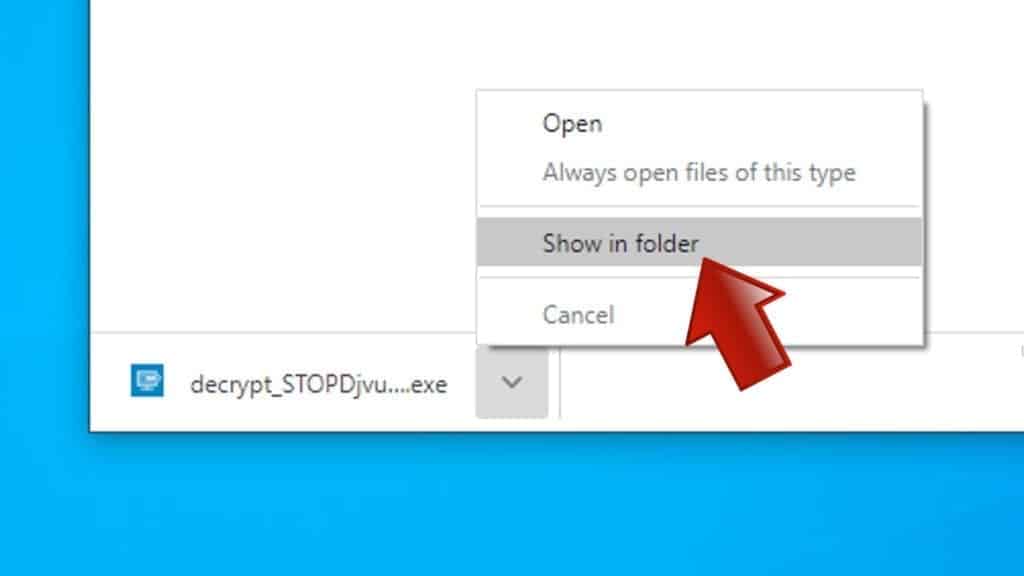
- Now, right-click the file and choose Run as Administrator. If asked, enter administrator's password.
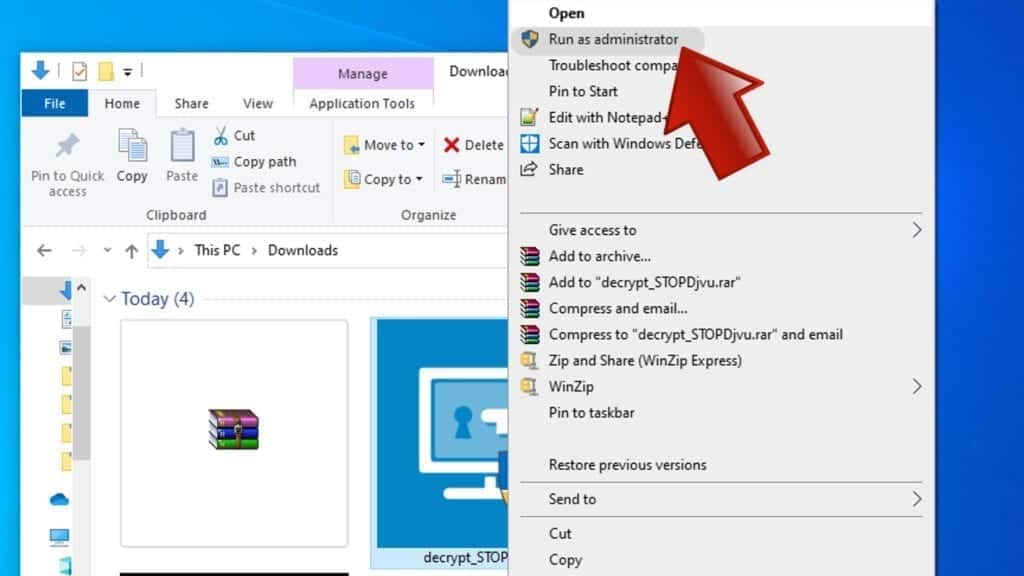
- In UAC window, click Yes.
- Click Yes to agree to software terms in both windows.
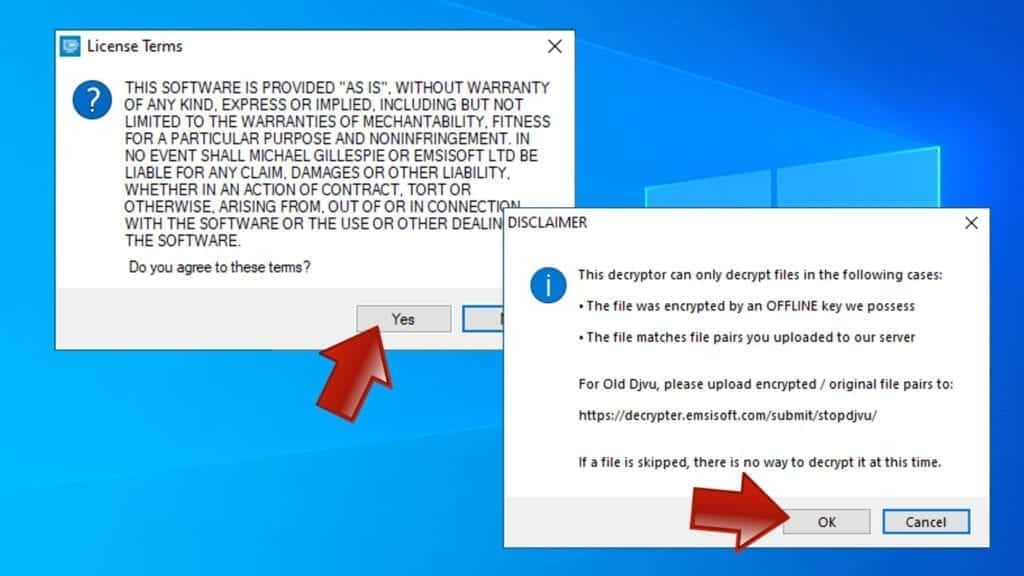
- The tool will automatically include C:// disk as a location to decrypt. The file recovery tool will prepopulate the locations to scan, including connected data storage drives or network drives. Click Add folder if you wish to add additional locations.
In Options tab, you can choose to keep encrypted file copies. We recommend leaving this option selected, especially if you do not know if the decryption tool will work.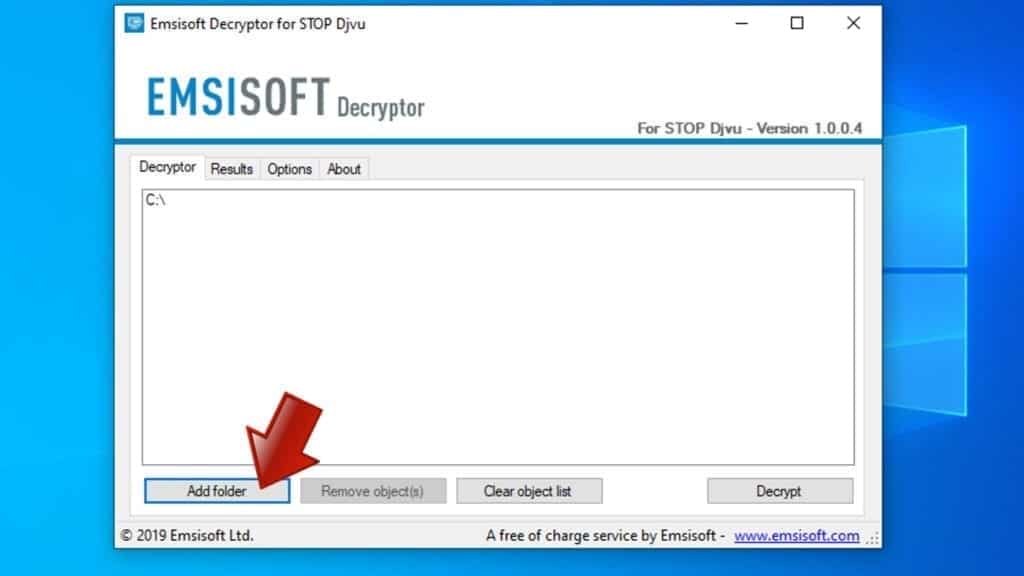
- Click Decrypt to start restoring AAMV files. You will see the progress in the Results tab. Here, you can see messages from the tool, such as whether the decryption procedure is successful, or you need to wait for an update.
You might also be informed that online key was used to encrypt your files. In such case, the decryption tool won't work for you, and the only way to recover your files is to use a data backup.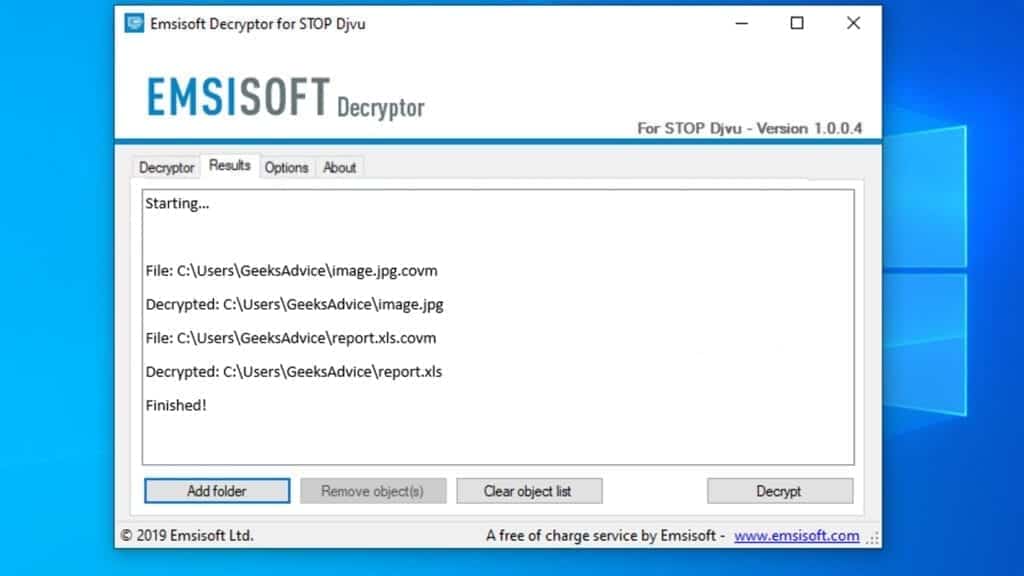
Meanings of decryptor's messages
The AAMV decryption tool might display several different messages after failed attempt to restore your files. You might receive one of the following messages:
Error: Unable to decrypt file with ID: [example ID]
This message typically means that there is no corresponding decryption key in the decryptor's database.
No key for New Variant online ID: [example ID]
Notice: this ID appears to be an online ID, decryption is impossible
This message informs that your files were encrypted with online key, meaning no one else has the same encryption/decryption key pair, therefore data recovery without paying the criminals is impossible.
Result: No key for new variant offline ID: [example ID]
This ID appears to be an offline ID. Decryption may be possible in the future.
If you were informed that an offline key was used, but files could not be restored, it means that the offline decryption key isn't available yet. However, receiving this message is extremely good news, meaning that it might be possible to restore your AAMV extension files in the future. It can take a few months until the decryption key gets found and uploaded to the decryptor. We recommend you to follow updates regarding the decryptable DJVU versions here. We strongly recommend backing up your encrypted data and waiting.
Report Internet crime to legal departments
Victims of AAMV Ransomware Virus should report the Internet crime incident to the official government fraud and scam website according to their country:
- In the United States, go to the On Guard Online website.
- In Australia, go to the SCAMwatch website.
- In Germany, go to the Bundesamt für Sicherheit in der Informationstechnik website.
- In Ireland, go to the An Garda Síochána website.
- In New Zealand, go to the Consumer Affairs Scams website.
- In the United Kingdom, go to the Action Fraud website.
- In Canada, go to the Canadian Anti-Fraud Centre.
- In India, go to Indian National Cybercrime Reporting Portal.
- In France, go to the Agence nationale de la sécurité des systèmes d’information.
If you can't find an authority corresponding to your location on this list, we recommend using any search engine to look up "[your country name] report cyber crime". This should lead you to the right authority website. We also recommend staying away from third-party crime report services that are often paid. It costs nothing to report Internet crime to official authorities.
Another recommendation is to contact your country's or region’s federal police or communications authority.
Frequently Asked Questions
You can only open AAMV files if you have the decryption key, or if you were affected by offline encryption type.
To figure out whether you were affected by offline encryption, please go to C:/SystemID/PersonalID.txt and see if the string inside of it ends in t1. You can also try using Emsisoft Decryptor for STOP/DJVU.
Please follow the guidances provided by the official AAMV decryption tools and believe what they say. If they say it is impossible to decrypt, it really is so. There is no magic tool or human capable of decrypting your files hiding somewhere. Encryption is a technique created to be nearly impossible to decrypt without a special private key (held by the criminals).
We advise scanning with anti-virus, anti-malware, malware removal tools or software like RESTORO to eliminate virus damage on the system. If you do not trust using a single tool, try running one after another. However, we do not recommend keeping several security programs on a computer at once as they can interfere with each other's work.
Beware of fake AAMV decryption tools circulating around the web. Cyber criminals are uploading them to various shady websites, also might be promoting them via suspicious Youtube videos. These programs can infect your computer even more heavily (Trojans, miners, etc.). We suggest being extremely cautious around the web. If there will be an official STOP/DJVU decryption tool available, it will be widely discussed in public media.

Norbert Webb is the head of Geek’s Advice team. He is the chief editor of the website who controls the quality of content published. The man also loves reading cybersecurity news, testing new software and sharing his insights on them. Norbert says that following his passion for information technology was one of the best decisions he has ever made. “I don’t feel like working while I’m doing something I love.” However, the geek has other interests, such as snowboarding and traveling.
Leave a Reply